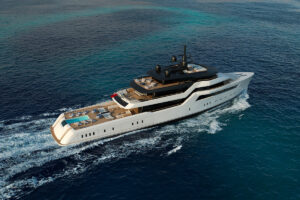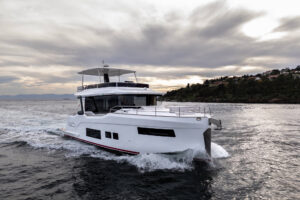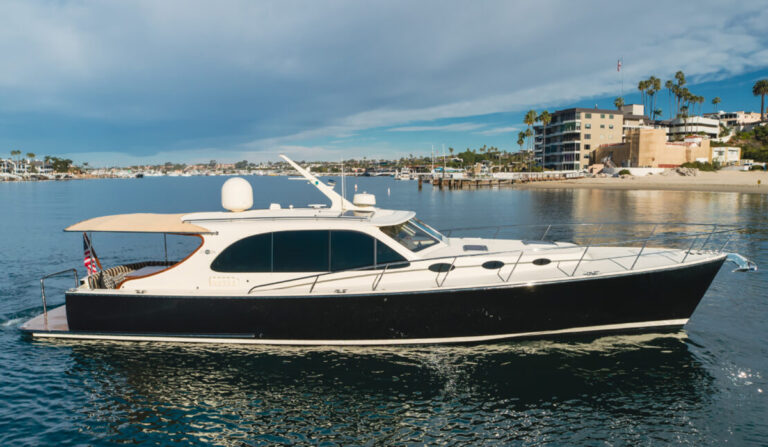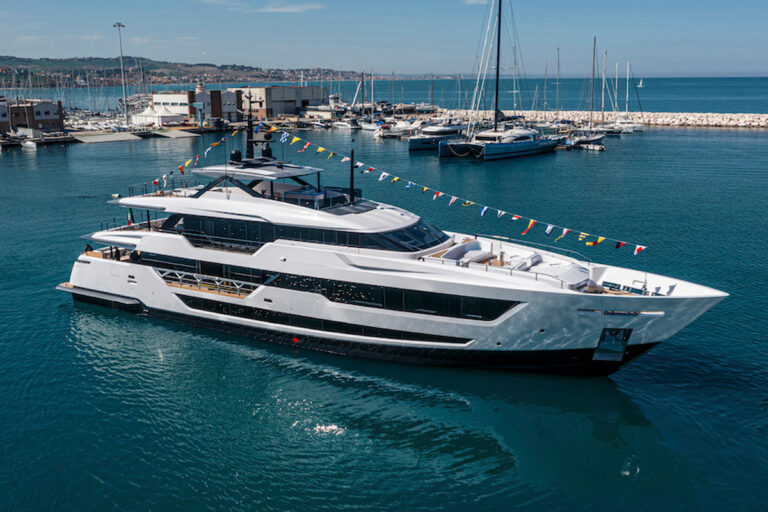Eckart Straub had no interest in stopping at his South Beach, Miami, hotel following the 10-hour flight from Germany. A stocky man with a bubbly personality, he headed straight for the boat he was prepared to buy. He and his wife, Kathryn, hurried down the dock, and he struggled to appear reserved as they approached the 131-foot Cheoy Lee Shango.
“I had to be careful not to be too enthusiastic, to make it too easy for the broker, but from the first moment, I knew,” he recalled in a whisper. “Eureka. I had found it.”
He meandered along the dock and let the impression settle in. The silhouette was a bit off in his mind, stopping too short in the front, but the lines after the bow were beautiful. The canoe stern was fantastic, and the thick fiberglass hull made her more than seaworthy.
He stepped on board, where Kathryn was already discussing how she would redecorate the interior. Straub liked the interior, but knew he would need five staterooms, not four, for the charter business he hoped to build.
“A charter yacht of 131 feet should really accommodate 10 guests,” he said.
Straub then wandered to the bridge and found logs detailing Shango‘s past. The records revealed she was launched in 1978 as a staysail ketch and had been, for years, the largest fiberglass yacht in the world. She was custom-built for a Holocaust survivor who wanted the ability to stay at sea for a year should World War III erupt. The yacht proved her worth during her maiden voyage, a circumnavigation.
“It was like a novel that you can’t put away,” Straub said. “It hooked me. I said, ‘This is exactly what I would like a yacht to be able to do.'”
Ten days later, in April 2000, Straub bought Shango, renamed her Lady Kathryn and began a refit. The result garnered enough attention at last winter’s charter show in Antigua that this December, Lady Kathryn will return under the management of Yachting Partners International.
“I loved her from the first moment I saw her,” Straub said. “I saw great potential.”
A Dream, a Rustpot and Julio Iglesias
The path that led Straub to that Miami dock had begun in Germany’s 900-year-old Hornberg Castle. Several decades ago-inside walls that had protected members of the Staufer dynasty, which ruled the Holy Roman Empire from 1138 to the mid-1200s-a young Eckart Straub could be found in a sailor’s outfit, tucked into a “baby backpack” on his parents’ shoulders aboard the family’s sailing yachts. A love of the sea gripped him early, but his appreciation of sail was loose, at best.
“My dream was always a powerboat,” he said, “because of the comfort.”
He would realize that dream with his first boat, the 60-foot custom motoryacht Kathryn. “It was custom, all mine, and I was sure it was the last yacht I would ever own,” he said.
Then came the tall ship, and a visit from Julio Iglesias.
In 1987, some friends told Straub of Godewind, a 168-foot, three-masted schooner whose moniker, meaning “the wind of gods,” had graced her hull since 1917. Crafted of riveted steel, she was said to be the last sailing ship built in Germany without an engine.
She was about to be destroyed, Straub’s friends said, asking for preservation funds. They appealed to his love of the sport, to his German honor and to his family’s tradition on the water.
“It was a rustpot,” Straub said with a fond chuckle, recalling how he bought Godewind the next day.
It took two years to refit Godewind into a 14-cabin charter boat. “I called it after my sea hero, Sir Francis Drake,” he said. “I wanted her in the Virgins, right there in the channel.”
That’s where Sir Francis Drake stayed, building a charter reputation while Straub enjoyed his 60-footer. He never dreamed of chartering Kathryn until 1990, when he agreed to an exception for a friend of a friend, singer Julio Iglesias.
“That prompted a lot of other celebrities to call, and I said, ‘No.’ That yacht was too much of my heart,” he said.
Eventually, Straub acquiesced. In 1990, he sold Kathryn into charter and focused on Sir Francis Drake. He walked with pride across her decks for the next nine years.
“We were somebody,” Straub said. “We really sailed.”
In November 1999, he helped sail her into St. Maarten, just on the edge of Hurricane Lenny. There were 1,000 bottles of Moà«t champagne on board, purchased in anticipation of an upcoming millennium cruise, when the crew dropped two anchors and tied the yacht to a pair of cruise ship moorings. Straub and his captain were preparing to see Sir Francis Drake through the storm when they heard a knock from above.
“The police came and said, ‘You must go,'” Straub recalled. Predictions were for Lenny to slam into the island, and evacuation was under way. Straub and his captain reluctantly followed the officers off the boat and into shelter.
“When the hurricane was over, we looked out,” Straub said. “There was no more boat.”
The last thing the authorities reported seeing of Sir Francis Drake were her three masts, intact and upright, heading out to sea. There was nobody at the helm.
“We said, ‘Never a ship again.’ The pain was too much,” Straub said.
“And that lasted about three months.”
Lady Kathryn Is Born
Straub set a goal of returning to the sport by combining his childhood passion for power, his learned love of charter and his new desire for a grand, global cruiser.
“I didn’t want a modern design,” he said, making a face like a child told to eat his broccoli. “They’re plastic, tall boats made for a good party in the port. I wouldn’t want to be on them in bad weather.”
He believed Lady Kathryn could fulfill his wishes, but he knew she needed some work. He called old friend Terry Parker, an architect in Kenilworth, New Jersey. The two had worked together for decades in land development, one of the many services Parker Associates offers. Since starting the firm in 1969, Parker’s work has included designing Yogi Berra Stadium and renovating the oldest residence at West Point, but he had never done yacht design.
Still, Straub had a hunch his old friend would help him.
“Not only does he do great architectural work,” Straub said, “but he’s a boat owner himself.”
Indeed, Parker had played at designing keels in the spare time he didn’t spend with his wife and two children aboard their 37-foot Ron Holland-designed Mistral. He saw Lady Kathryn as an interesting challenge.
Straub gave Parker three goals: Create a new owner’s suite for charter, modernize the ship’s plumbing and safety systems, and fix the silhouette problem he noticed in Miami in April.
Oh, and get it done for December’s charter show in Antigua.
“I said, ‘Ohhh Kaaay, wait a second,'” Parker recalled with a laugh, looking a bit like jolly St. Nick with his glasses, salt-and-pepper mustache and beard. “There were so many things to do, you didn’t know where to turn first.”
Parker called Cheoy Lee for the 131’s original staysail ketch plans. One of her two previous owners had taken down her mast, but she otherwise had undergone few renovations.
“I didn’t want to do anything that would change the way the boat looked or felt,” Parker said. “I wanted it to look like part of the original.”
The yacht had an owner’s suite on the main deck and three guest staterooms below (one double, two twins). The space where a fourth might be placed belowdecks had been turned into a second saloon, which Straub did not want to give up.
“My idea was to create a yacht that two families could share, with two owner’s suites,” Straub said. He saw the belowdecks saloon as a valuable charter selling point for families. “When children have their own realm and they can entertain themselves, the grownups have the freedom to enjoy themselves.”
Parker instead looked to the captain’s cabin abaft the bridge. It opened onto a private afterdeck with a jacuzzi that could be updated, along with the cabin, to create a second owner’s suite. Parker penned a new captain’s cabin on the main deck forward of the existing owner’s suite, which solved both the accommodations challenge and the “short silhouette.”
“We really didn’t want it to look like we’d put an addition on,” Parker said. “We wanted to maintain the character of the boat.”
To fill in the gaps in his knowledge, Parker enlisted New York naval architects McCurdy and Rhodes. Once his design ideas were deemed doable in terms of stability, he set about turning the old captain’s cabin into the “admiral suite.” He tried to mimic the yacht’s curves in his computer drawings, pushing the room’s focus toward the private afterdeck by “floating” the berth in the center of the room and keeping every possible corner rounded for the rough seas the global cruiser will inevitably encounter.
Parker next tried to find a craftsman who could do the custom cabinetwork in the time allotted. By July, he and Straub grew concerned. The Antigua charter show was in five months, the bids for the admiral suite’s woodwork alone were between $75,000 and $200,000, and the only craftsmen available had little to no experience with yachts.
Straub again turned to an old friend, Tilo Kiess, who had done the cabinetwork at Hornberg Castle. Straub had watched Kiess’s talent grow for 20 years as he worked in German hotels, Saudi palaces and the homes of Spanish kings.
“I showed him the plans,” Straub said, “And he said, ‘Yes, I can do that.'”
Kiess and Parker e-mailed for several days, tweaking the stateroom’s design in three-dimensional computer renderings. In six weeks, Kiess had built all the furniture in his shop in Germany. He was ready to ship the pieces by early October.
Meanwhile, Parker was aboard Lady Kathryn in New Jersey, updating everything he could. Her original twin Volvo diesels had never been overhauled. She had original fuel injectors. She needed a GPS upgrade and computers.
“You couldn’t replace everything all at once,” Parker said, “so we tried to find the critical things.”
In October-with Kiess’ container ready to be sent, hurricane season in full swing and the Antigua charter show in about eight weeks-Straub decided to get Lady Kathryn as close to Antigua as possible and ship the cabinetwork to meet her.
“Eckie had a friend in Martinique,” Parker said of Straub, “so we could get yard time and labor while everyone else was trying to get the same thing.”
Lady Kathryn pulled into Martinique the day before Kiess’ container, which arrived the same day as Kiess and another German cabinetmaker. They assembled the admiral suite in 10 days, including the gold-flecked granite countertops from India. Silk wall coverings followed, along with commissioned watercolor accents. The yacht made her charter debut on time in Antigua, with Parker turning hospital corners in the cabins by day and finishing systems work at night.
“We went 100 percent over budget,” Straub said, “but it was worth it. I want to have created something new that makes a good entrance into the market, which is not easy today because there is a lot of competition.”
Lady Kathryn will return to Antigua this year under the flag of Yachting Partners International, which is working with Straub on further improvements. Among them are Parker’s ideas for roller-furl awnings and an admiral suite skylight.
Straub says he intends to follow his old friend’s advice, but this time, he’s adding a caveat.
“I told him later that it was much more expensive than I thought, and he said, ‘I know, but if I told you that before, you would have never done it.’
“This time,” Straub said with a wide grin, “I’m asking for the price.”
Contact: Yachting Partners International, (800) 626-0019; (011) 44 12 73 57 17 22; fax (011) 44 12 73 57 17 20; ypi@ypi.co.uk; www.ypi.co.uk. Lady Kathryn summers in the Mediterranean and winters in the Caribbean at $42,000 per week for 10 guests, plus expenses. Parker Associates, (908) 259-0630; fax (908) 259-0635; paarchitect@aol.com.









